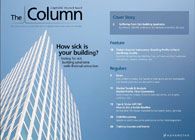Harmful plasticizers
Two scientists from Uludag University in Turkey have examined the potential transfer of harmful phthalates from toys onto the skin of children via sweat.
Two scientists from Uludag University in Turkey have examined the potential transfer of harmful phthalates from toys onto the skin of children via sweat.1 Using an artificial sweat formula of sodium chloride, urea and lactic acid they extracted di(2-ethylhexyl) phthalates using GC–MS following activated carbon enrichment of samples.
The ultimate analytical conditions for the simultaneous determination of analyte from spiked artificial sweat was: pH (3.1), activated carbon amount (1.4 g L−1), adsorption time (55 min) and elution solvent (chloroform). These conditions were applied to study the migration of di(2-ethylhexyl) phthalate from three different children’s toys into artificial sweat. The detection limit of the method was 13.8 μg L−1, while the relative standard deviation value for the analysis of 100 µg L−1 (%) of the analyte was below 3.7% (n = 5).
The team concluded that their method will allow the transfer of di(2-ethylhexyl) phthalates from toys to sweat to be estimated in future studies and risk assessments.
1. Elif Tümay Özer and Seref Güçer, Polymer Testing, 31(3), 474–480 (2012).
This story originally appeared in The Column. Click here to view that issue.
A Novel LC–QTOF-MS DIA Method for Pesticide Quantification and Screening in Agricultural Waters
May 8th 2025Scientists from the University of Santiago de Compostela developed a liquid chromatography quadrupole time-of-flight mass spectrometry (LC–QTOF-MS) operated in data-independent acquisition (DIA) mode for pesticide quantification in agriculturally impacted waters.
Investigating 3D-Printable Stationary Phases in Liquid Chromatography
May 7th 20253D printing technology has potential in chromatography, but a major challenge is developing materials with both high porosity and robust mechanical properties. Recently, scientists compared the separation performances of eight different 3D printable stationary phases.

.png&w=3840&q=75)

.png&w=3840&q=75)



.png&w=3840&q=75)



.png&w=3840&q=75)










